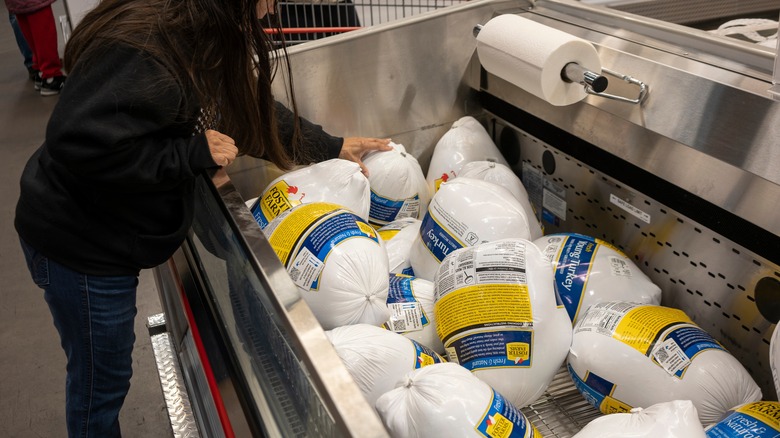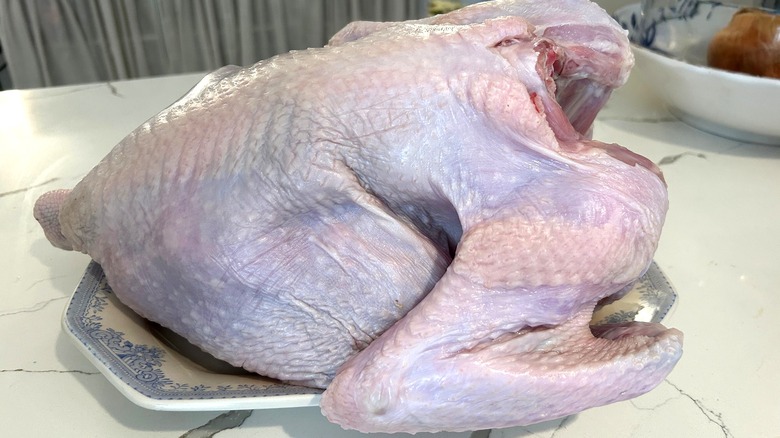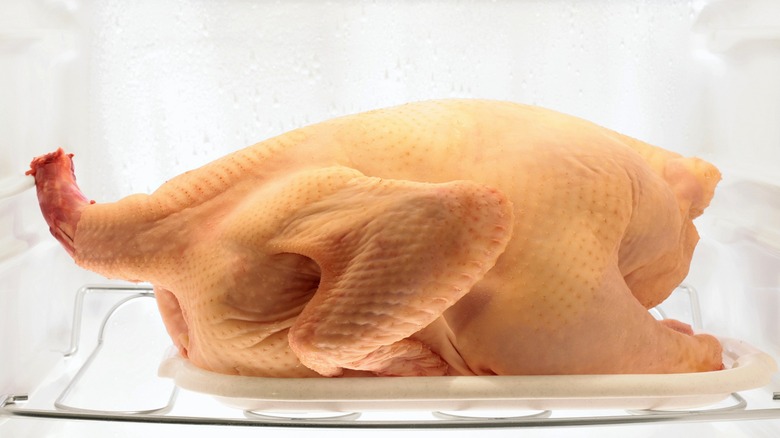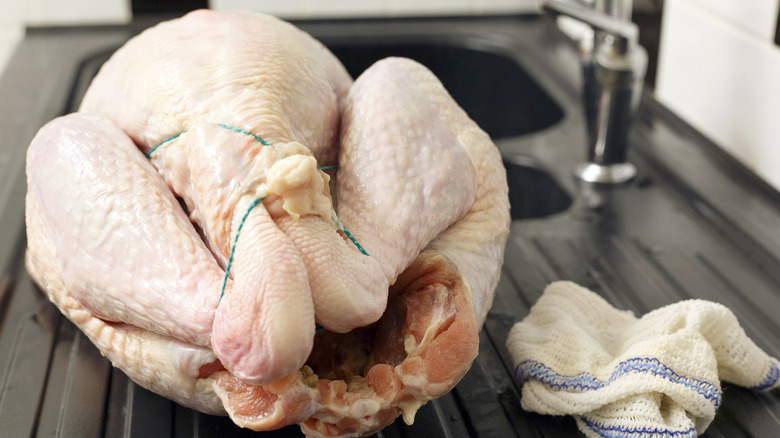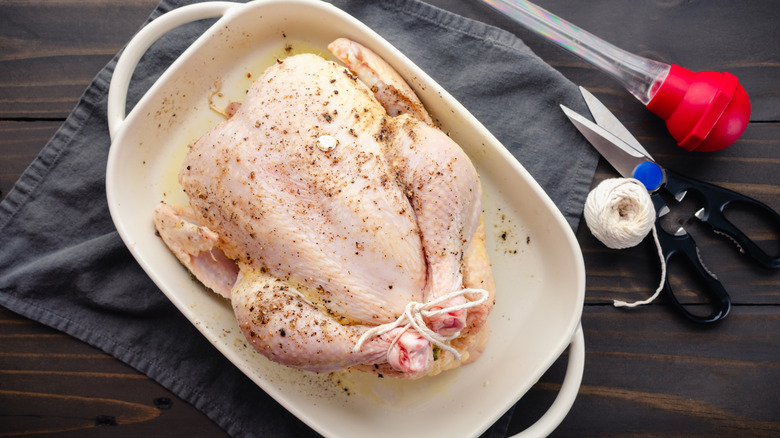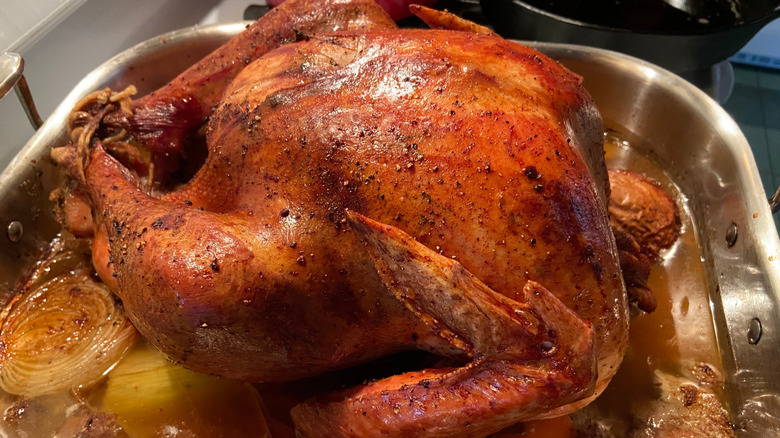The Most Common Mistakes People Make When Cooking Thanksgiving Turkey
We may receive a commission on purchases made from links.
Thanksgiving is a time to gather with family and friends to reflect on all the things for which we have to be grateful. It is also a time to enjoy a delicious meal together. The star of that meal must be the turkey, and the origins of eating Turkey on Thanksgiving trace back many years. While it wasn't a part of the first Thanksgiving dinner, turkey became an integral component of the meal during the 1800s. With turkey being an integral part of the meal, the pressure is on to make sure it comes out of the oven crisp, juicy, and delicious.
Unfortunately, achieving perfection when cooking a turkey is no easy feat. Several mistakes can stand in your way and threaten your entire Thanksgiving feast. If you want to avoid cooking a turkey that turns out too dry, lacking flavor, or still raw in the center, continue reading. We've outlined some of the most common mistakes that can cause Thanksgiving turkey trouble.
Buying a turkey that's the wrong size
If you're hosting Thanksgiving dinner, the last thing you want is not have enough turkey to feed all of your guests. However, even though turkey prices may be down this year, you don't want to buy more than you need. Sure, you want some leftovers, but do you want to eat turkey all day, every day after the holiday? The key to avoiding these catastrophes is buying an appropriately sized turkey to match the number of dinner guests you'll have.
There isn't a hard and fast rule for this, but as a general guideline, you should aim to purchase at least 1 pound of turkey for each person eating. This means that you should have 10 pounds of turkey for 10 people. However, this formula doesn't account for leftovers. If you want more leftovers or want to send leftovers home with your guests, aim to purchase about 1.5 pounds of turkey per person — or a 15 pound bird for 10 guests.
Not thawing it properly
Always keep your safety and that of your guests in mind when preparing and thawing your turkey. If you purchase a frozen turkey, never leave it out on the counter to thaw. This method is unsafe because the outside of the bird will thaw much more quickly than the center. As the outside thaws and warms up, its temperature could enter the danger zone. This is the temperature range between 40 and 140 degrees Fahrenheit, where bacteria multiply rapidly, increasing the chances that you'll be serving a portion of food poisoning to your guests.
The USDA highlights three safe methods for thawing a turkey. One option is to thaw it in the refrigerator. Just remember, because the turkey is so large, it is going to take a while to thaw, so you'll want to give it 24 hours per each 4 to 5 pounds of weight (always place it in a container to ensure raw juices don't contaminate other foods in the fridge). If you don't have enough time to thaw in the fridge, you can also try thawing the turkey in cold water (as long as you'll be baking it immediately after it's thawed). This will take about 30 minutes per pound and will require you to change the water once every 30 minutes to ensure it doesn't get too warm. As a final option, you could try the microwave, but you'll have to cook the turkey immediately in case parts of it have warmed up too much.
Not cooking a frozen turkey long enough
If you didn't plan far enough ahead or forgot how long it takes to thaw a turkey, all is not lost if your bird is still frozen on Thanksgiving. While it might not be ideal, you can still cook a frozen turkey. However, if you don't leave extra time to let it cook, your timing for the meal is going to be way off. A frozen turkey will take a minimum of 50% longer to cook than a thawed one. This means that if the turkey takes about 4 hours to cook when thawed, it will take at least 6 hours to cook if it is still frozen.
Alternatively, you could try thawing the turkey in water enough to cut it apart. You could then cook the legs, thighs, and breasts individually, which won't take as long as a whole bird.
Leaving the giblets in the turkey
When you purchase a turkey from the grocery store — or even a butcher — the giblets may be left inside the cavity of the bird. If you're unfamiliar with giblets, they are the edible turkey organs, such as the heart, neck, gizzards, or liver. While these are edible, you will need to remove them from the turkey to cook them separately. Do not leave them in the cavity; they may not cook properly or turn out the way you'd like them to.
Leaving the giblets inside the bird can pose another potential problem. Manufacturers often package giblets in plastic bags. If you leave them inside the turkey as it cooks, the plastic can melt and leach dangerous chemicals into the turkey. This means you'd need to discard the whole bird, ruining Thanksgiving dinner for everyone. Not ideal.
Moving the turkey directly from the fridge to the oven
The last time you cooked a turkey, did you take it out of the refrigerator, plop it in your roasting pan, and immediately put it in the oven? If so, that was a mistake. Putting a cold turkey in the oven can have a few negative consequences. First, when the poultry comes out of the fridge, it is very cold. Colder meat will take longer to cook than that which has warmed up a bit. Turkey cooked right from the refrigerator may also turn out overly dry and not as juicy as one allowed to come to room temperature before cooking.
The key is to leave your bird out for about an hour. You don't want to leave it out longer than 2 hours, as this is the limit the USDA recommends to ensure food safety and ensure perishable foods don't enter the danger zone where bacteria multiply rapidly.
Washing the turkey
Perhaps you learned to wash turkey and other meat before cooking them. You may have been taught that doing so removes harmful bacteria from the bird before you cook it, decreasing the risk of food poisoning or other issues. However, washing turkey is a big mistake. First, it won't accomplish your goal of washing away bacteria. There is so much bacteria on raw poultry that you realistically won't be able to wash it off. The best thing is to ensure your turkey is fully cooked to kill all bacteria.
The real problem with washing turkey is that it will increase the risk of food poisoning for you or your guests. Just as you don't want a food safety mistake to ruin a summer BBQ, you also don't want to threaten the health of your Thanksgiving dinner guests. When you wash a turkey, some of the raw juices will inevitably splash around your sink — landing on dishes, countertops, and potentially nearby food items. This cross-contamination can have serious implications, so don't take the risk of washing your bird.
Not brining and properly seasoning the turkey
While brining a turkey isn't a necessity, you might be making a mistake by not giving it a try and seeing what a difference it can make in how the finished bird tastes. Brining is a process that involves soaking a turkey (or other types of meat) in a solution that is heavily salted. One benefit of brining is that it helps improve the moisture content of the bird. Soaking it in the salty solution leads to osmosis, where the muscle tissue's texture is altered and can absorb more liquid.
In addition to brining, you should also consider how you will season the turkey to ensure it tastes delicious. Consider rubbing the skin with a mix of salt, pepper, thyme, rosemary, or garlic, creating a compound butter with your favorite herbs and spices, or putting some aromatics — such as onion and garlic — inside the cavity before you cook the bird.
Forgetting to prep the bird for the oven
If you've never cooked a turkey before, you might assume you can remove it from the packaging and put it right into the oven. However, a little more prep work is necessary if you want the turkey to cook properly and end up tasting as good as possible. To start, make sure the turkey is positioned correctly in the pan, with the breasts up. Then, rotate the pan until the legs are right in front of you, and tuck the tips of the wings underneath the front of the turkey. This will help ensure they don't burn while the bird cooks.
Next, you'll need to truss the turkey, which involves tying the wings and legs to ensure the bird is more compact for even cooking. To do so, you'll need to wrap a long piece of butcher's string, such as the Regency Wraps butcher's cooking twine, around the neck, over the wings, and then around the legs to tie them together. Wrap the string a few times to help ensure everything stays in place, knot it, and trim off any excess.
Using a pan without a roasting rack
If you're hosting Thanksgiving for the first time this year, you might not have a roasting pan with a large enough rack to hold a turkey. It is natural to wonder whether this is actually necessary or if you'll just be able to use another pan or baking dish that doesn't have a rack. While the roasting rack may not be essential, you'll want to find some way to elevate the bird to ensure it cooks properly.
If you just put the turkey against the bottom of the baking dish or pot, air won't be able to circulate its underside. This will lead to soggy skin, which isn't all that appetizing. Conversely, with a rack — or at least some rolled-up aluminum foil or even a wire cooling rack for cookies — the air will circulate and crisp up the skin nicely.
Another thing to consider is how deep the baking dish is. If you try to cook your turkey on a cookie sheet or a very shallow pan, it could easily slide off when you put it in or take it out of the oven. Similarly, all the drippings could end up spilling or splattering out. Overall, an investment in a good roasting pan with a rack, such as the Circulon nonstick roasting pan (with rack) or the Glad nonstick roasting pan, might be a wise decision, especially if you plan on cooking turkey more than once.
Basting too frequently
Basting is a step you won't want to skip when you cook a turkey. It helps ensure the bird stays moist and flavorful. Moreover, it helps keep the breasts from cooking too quickly. They will turn out overly dry when they cook faster than the dark meat.
However, as important as basting can be, you should avoid basting your turkey too frequently. Each time you baste the turkey, you have to open the oven. Every time you open the oven, heat escapes, and it takes a while to get back to the set temperature once the door is closed again. Doing this too often will make the turkey take longer to cook and throw off your timing for all your side dishes. As a general rule, aim to baste the turkey about once every 40 minutes or so. This should be frequent enough to maintain the necessary moisture levels but not too often that your oven loses too much heat.
Under- or overcooking the turkey
One of the biggest mistakes you'll want to avoid when hosting Thanksgiving dinner is serving your guests turkey that is over- or undercooked. Overcooked turkey is dry and very unappetizing. Undercooked turkey can be even worse, posing a food safety risk and threatening your guests with food poisoning.
So, how do you know when a turkey is perfectly cooked and ready to remove from the oven? Here's a hint: It isn't by relying on the pop-up timer (if your bird has one), looking at the color of the skin, or noting how much or how easily the legs wiggle back and forth. While these may all provide some clues, the only safe way to ensure that a turkey is cooked is by using a meat thermometer. The inner thighs should reach a minimum temperature of 180 degrees Fahrenheit, and the breasts should reach a minimum temperature of 170 degrees Fahrenheit. If you don't have a meat thermometer, they can be purchased for around $10.
Cooking a stuffed bird
Stuffing is a traditional Thanksgiving side dish. However, the USDA advises against cooking stuffing inside a turkey due to the increased risk of food poisoning. To be safe and free of bacteria and potentially harmful contaminants, stuffing must reach an internal temperature of 165 degrees Fahrenheit.
The problem is that stuffing doesn't always heat up as quickly as the rest of the turkey. When your meat thermometer registers 180 degrees inside the turkey thigh, prompting you to remove the bird from the oven, you could create a safety hazard if the stuffing isn't thoroughly cooked. But, if you decide to cook the stuffing inside the bird, it is also essential to check its internal temperature. The safest option would be to cook your stuffing in a roasting pan so that you don't have to worry about it becoming contaminated with raw turkey juices that don't aren't properly cooked.
The USDA makes one distinction to its general guidelines to avoid cooking stuffed turkeys. If you purchase a frozen, pre-stuffed turkey that has been stuffed at a USDA-inspected plan, it will be safe to eat as long as you follow the cooking directions from the manufacturer and cook it from frozen.
Not knowing how (and when) to carve your turkey
Turkey is not something most of us make on a regular basis. So, it is completely understandable if you don't consider yourself an expert on carving a turkey. Be sure to take a few minutes to brush up on your skills before serving your guests.
First, always start with the turkey on a large cutting board with the breast side facing up. Use a sharp knife to cut the legs and thighs off by cutting through the skin and then slicing through the joint. Once removed, find the joint between each leg and thigh and slice through it to separate them. Next, pull the wings out before slicing through their joint to cut them off the turkey. Finally, you're ready to remove the breast meat by slicing it off as close to the bone as you can manage. With the meat on the board (skin side facing up), you're ready to cut it into smaller pieces.
There is one more crucial tip about carving a turkey. You don't want to start cutting it immediately after the bird is removed from the oven. Giving the turkey a rest period of at least 20 minutes is crucial. During this rest period, the meat will absorb more of the moisture. If you cut it too quickly, all of these extra juices will just run out onto your cutting board, leaving you with dry meat.
Pouring the pan drippings down the drain
Whatever you do, don't make the mistake of pouring the pan drippings down the drain after your turkey has finished cooking. First, you don't want to lose this liquid gold. Combining turkey drippings with a few simple ingredients can yield a delicious gravy – the ultimate topping for the meat or mashed potatoes. You only need a little flour, water, broth, and salt and pepper to easily whip up a scrumptious homemade gravy.
The other reason you don't want to pour the drippings down the sink is because of the havoc they can wreak on your drain and disposal system. Sure, when the turkey is fresh out of the oven, the drippings are very liquidy and look like they'll easily flow through your pipes. However, these drippings consist of a lot of fats and oils. As they cool, they'll solidify and likely clog your pipes.
Attempting to deep fry the turkey — especially inside the house
Deep-frying a turkey may sound like a good way to put a fun spin on Thanksgiving dinner this year. However, it probably isn't something you'll want to attempt, especially if you're not experienced. Each year, fire departments across the U.S. respond to hundreds of home fires on Thanksgiving. The cause of many of these fires? A deep-fryer. If the hot oil spills or splatters, it can easily start a fire.
If you're set on deep-frying your turkey this year, take as many safety precautions as possible. First, never use a deep-fryer inside the house. Set it up several feet away from your home — and anything else that could catch on fire. You should also make sure it is on a flat surface and work carefully to avoid splashing any oil out when you put the bird in or remove it from the fire. Always make sure you're using the correct amount of oil; you can test this first with cold water to see if it overflows when the turkey is placed inside. Finally, never leave the fryer unattended as your bird cooks.
I synthesized information from multiple resources when compiling this list of common mistakes people make when cooking a turkey on Thanksgiving. These sources included the USDA, chefs and recipe creators, and manufacturers. Additionally, I leaned into my personal experiences with cooking Thanksgiving dinner several times over the past few years. I reflected on what went well, and what didn't go so smoothly, to try to help others pull of their holiday meal without a hitch.
Methodology
I synthesized information from multiple resources when compiling this list of common mistakes people make when cooking a turkey on Thanksgiving. These sources included the USDA, chefs, recipe creators, and manufacturers.
Additionally, I leaned into my personal experiences with cooking Thanksgiving dinner several times over the past few years. I reflected on what went well and what could have gone better to try to help others pull off their holiday meal without a hitch.

